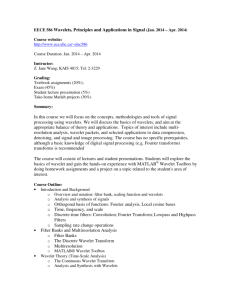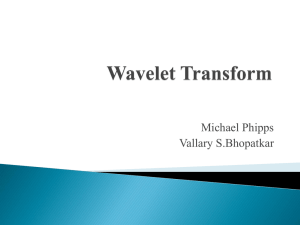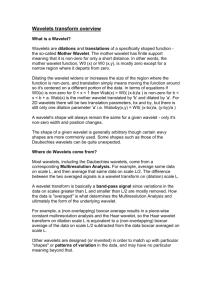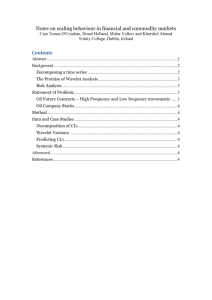Multiscale Mapping of fMRI Information
advertisement
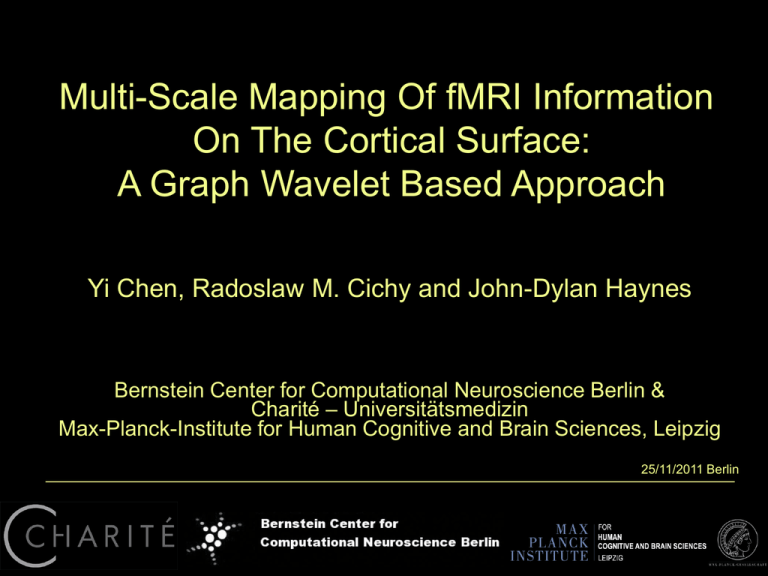
Multi-Scale Mapping Of fMRI Information On The Cortical Surface: A Graph Wavelet Based Approach Yi Chen, Radoslaw M. Cichy and John-Dylan Haynes Bernstein Center for Computational Neuroscience Berlin & Charité – Universitätsmedizin Max-Planck-Institute for Human Cognitive and Brain Sciences, Leipzig 25/11/2011 Berlin Multivariate Pattern Analysis of fMRI Signal ? Pattern Recognition Haxby et al. Science, 2001 Spatial Range of MVPA Methods Global Whole brain Local ROI-based Searchlight technique Searchlight technique affords unbiased, spatially localized information detection. • Haxby et al., Science, 2001 Haynes & Rees, Nature Rev. Neurosci, 2006 Kriegeskorte et al., PNAS, 2007 The fMRI Signal in Space Information carried by the structure: fMRI signals resides in the convolved cortical The brain has a complex sheets. BOLD changes 3D searchlight methods do not take this structural complexity of the brain into account. 3D searchlight • Jin & Kim, Neuroimage, 2008 Cortical Surface-based Searchlight Searchlight on cortical surface mesh 3D searchlight neglects local geometry Surface-based searchlight respects local geometry • Chen et al., NeuroImage, 2011 Application: Decoding Object Category Object categories: Trumpets vs Chairs vs Boats Chen et al., NeuroImage, 2011 Surface-based vs 3D Method Collateral sulcus Fusiform gyrus Surface-based method observes local structure Collateral sulcus Fusiform gyrus 3D method deteriorates spatial specificity Surface-based method localizes fMRI information more precisely • Chen et al., NeuroImage, 2011 Multiscale Organization of Brain Function Hierarchical organization with increasing spatial scale V2 R V3 V1 V2 L V3 Ocular dominance and orientation preference columns Retinotopic maps Object selective regions Knowing the spatial scale of patterns is crucial for understanding the brain’s functional organization Yacoub et al., PNAS, 2008 Wandell, Encyclopedia Neurosci., 2007 Multiscale Analysis – Wavelet Transform Wavelets, or “little waves”, are families of spatially local, band-passing Fine scale wavelet filters: Fine scale detail Fine scale information Transform Output: Large scale information Scale up Large scale wavelet Large scale detail Information specific to different scales can be extracted with wavelets Hackmack and Haynes, in prep. Wavelets on Irregular Mesh Wavelets on regular grid Translation invariant Wavelets on irregular mesh Varies on translation On an irregular mesh, wavelet transform cannot be directly implemented Another Way to Look at Discrete Fourier Transform For a signal x defined on a one-dimensional, regular and circular field, we have: Discrete Laplacian: 1 1 xi ( xi 1 xi ) ( xi 1 xi ) 2 2 x K x where K is a symmetric matrix, its eigenvectors, when sorted non-decreasingly w.r.t. eigenvalues: 1/ n if j 1 (u j )h 1 / n sin( 2 h j / 2 / n) if j is even 1 / n cos( 2 h j / 2 / n) if j is odd Projecting a signal onto the space spanned by these eigenvectors is thus computationally equivalent to its Discrete Fourier Transform (DFT): xˆ U x Manipulating the transform coefficients and exploiting the unitary property of U, we can implement filters on the frequency domain. The filtered signal is given by: ~ x U T D f xˆ , where D f is a diagonal matrix The diagonal matrix D f contains the Impulse Response function of the designed filter. Taubin SIGGRAPH '95 Implementing Wavelets via Graph Laplacian Generalized graph Laplacian H: H f ( x) wxy f ( x) f ( y ) y~ x Wxy characterizes the geometric properties of the graph. The eigenvectors of graph Laplacian have a quasi-frequency property: Freq. Response Wavelets on irregular mesh can then be defined on the eigenspectral domain: Eigenspectrum Biyikoglu et al., Laplacian Eigenvectors of Graphs, 2007 Hammond et al., Applied & Comp. Harmonic Analysis, 2009 Multiscale Analysis on Irregular Mesh Fine scale wavelet Fine scale detail Fine scale information Transform Outputs Large scale information Large scale wavelet Spectral Large scale detail graph wavelets can be used to achieve multiscale analysis on irregular meshes Anisotropic Filters on Cortical Surface Vertical Horizontal Fine scale Large scale Anisotropic filters are possible by using different geometric schemes for the graph Laplacian Multiscale Analysis of Object Categories/Exemplars Categories: Objects vs Scenes vs Body parts vs Faces 2-step procedure: Exemplars: Child vs Female vs Male BOLD estimates were sampled onto the cortical surface & transformed with spectral graph wavelets At each scale, the outputs from the filter banks were taken as feature vectors for classification • Cichy et al., Cerebral Cortex, 2011 Scale Differentiated Analysis of Exemplar and Category Encoding Categories Exemplars Fine Scale Large Scale z-score Categories are preferentially encoded in large scale and exemplars in fine scale Summary Cortical surface-based method respects natural geometry of the brain - improves spatial specificity of MVPA - Multi-scale analysis on the cortical surface can extract information from fMRI signals at different scales using spectral graph wavelets - shows that object categories and exemplars are encoded in different spatial scales in the ventral visual stream - The combination of surface-based technique and multiscale information mapping promises a better understanding of human brain function Acknowledgements John-Dylan Haynes Radoslaw M. Cichy Jakob Heinzle Kerstin Hackmack Fernando Ramirez NEUROCURE Appendix Spectral Graph Wavelets & Fast Algorithm For filter with compact spatial support, its impulse response function defined on eigenspectral domain needs to be continuously differentiable. Wavelet functions are defined by a family of dilated versions of a single function (mother wavelet). Mother wavelet needs to meet the admissibility condition. g 2 ( x) 0 x dx Cg , g (0) 0 Fast algorithm is possible by approximating the wavelet function on eigenvalue domain with truncated orthogonal polynomials (e.g. Chebyshev polynomial), and calculating the eigenspace projection with recursive sparse matrix vector multiplications (Sect.6, Hammond et al., 2009). g (t ) Tt ( g ) pt ( ) Wt ( f ) TL,t f pL,t ( f ) Note, however, by adopting above fast algorithm, the dilation of mother wavelet is now carried on the eigenvalue domain, rather than the eigenvalue’s rank/index domain. Hammond et al., Applied & Comp. Harmonic Analysis, 2009 Multiscale Analysis on Regular Grid Fine scale wavelet Fine scale detail Fine scale detail Transform Outputs Large scale detail Large scale wavelet Large scale detail


